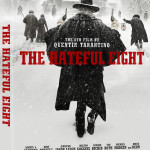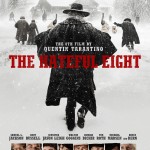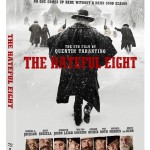THE HATEFUL EIGHT Arriving on Blu-ray Combo Pack, DVD and On Demand March 29, 2016
| Quentin Tarantino’s Academy Award Nominated THE HATEFUL EIGHT is now up for pre-order! Get details about this release below:
BEVERLY HILLS, CA (February 17, 2016) – Anchor Bay Entertainment and The Weinstein Company are proud to present the home entertainment release of the eighth film by two-time Academy Award® winner Quentin Tarantino (Django Unchained, Pulp Fiction). Shot entirely on 70mm and featuring a Golden Globe® and BAFTA® award-winning score by Oscar® winner Ennio Morricone (Bugsy, The Mission) THE HATEFUL EIGHT “absolutely delivers on the sheer moment-to-moment pleasures fans have come to expect — from dynamite dialogue to powder-keg confrontations,” Peter Debruge, Variety.An explosive frontier mystery about eight strangers with one deadly connection, THE HATEFUL EIGHT will be available for digital download on March15, 2016 from Starz Digital before heading to retail on Blu-ray™ Combo Pack ($39.99 SRP) and DVD ($29.98 SRP) from Anchor Bay Entertainment and On Demand March 29, 2016. Special features for THE HATEFUL EIGHT include two featurettes – “Beyond the Eight: A Behind-the-Scenes Look” and “Sam Jackson’s Guide to Glorious 70mm.”
Ultra Panavision 70 is the very rare and exceptional format that Quentin Tarantino and his team used to shoot THE HATEFUL EIGHT, the widest 70mm theatrical release in twenty years. Panavision’s unique anamorphic camera lenses capture images on film in an incredible aspect ratio of 2.76:1. Almost all films seen today are shot in ratios of either 1.85:1 or 2.39:1. Simply put, Ultra Panavision 70 provides an amazingly wide and more detailed image. THE HATEFUL EIGHT marks the triumphant return to the genre for legendary composer Morricone (The Good, The Bad and the Ugly, A Fistful of Dollars). Nominated for an Academy Award® for Best Original Score, Morricone is back in the saddle after nearly four decades since last scoring a full-length Western. Additional Academy Award® nominations include 3-time Oscar® winner Robert Richardson for Best Cinematography and Jennifer Jason Leigh for Best Actress in a Supporting Role. THE HATEFUL EIGHT’s notorious all-star cast also boasts Oscar® nominees Samuel L. Jackson (Pulp Fiction), Kurt Russell (Silkwood), Emmy® nominee Walton Goggins (TV’s Justified), Demian Bichir (A Better Life) and Tim Roth (Rob Roy). In THE HATEFUL EIGHT, set six or eight or twelve years after the Civil War, a stagecoach hurtles through the wintry Wyoming landscape. The passengers, bounty hunter John Ruth (Kurt Russell) and his fugitive Daisy Domergue (Jennifer Jason Leigh), race towards the town of Red Rock where Ruth, known in those parts as “The Hangman,” will bring Domergue to justice. Along the road, they encounter two strangers: Major Marquis Warren (Samuel L. Jackson), a black former union soldier turned infamous bounty hunter, and Chris Mannix (Walton Goggins), a southern renegade who claims to be the town’s new Sheriff. Losing their lead on the blizzard, Ruth, Domergue, Warren and Mannix seek refuge at Minnie’s Haberdashery, a stagecoach stopover on a mountain pass. When they arrive at Minnie’s, they are greeted not by the proprietor but by four unfamiliar faces. Bob (Demian Bichir), who’s taking care of Minnie’s while she’s visiting her mother, is holed up with Oswaldo Mobray (Tim Roth), the hangman of Red Rock, cow-puncher Joe Gage (Michael Madsen), and Confederate General Sanford Smithers (Bruce Dern). As the storm overtakes the mountainside stopover, our eight travelers come to learn they may not make it to Red Rock after all… |
February 18, 2016 Posted by Arnie C | Movies, News | Blu-ray, DVD, Film, Hateful Eight, Movie, Movies, News, Now Playing, Now Playing Podcast, Pre-Order, Press Release, Quentin Tarantino, Samuel L Jackson | Comments Off on THE HATEFUL EIGHT Arriving on Blu-ray Combo Pack, DVD and On Demand March 29, 2016
Hollywood Shuffle: Inside the Now Playing Podcast schedule
We were supposed to be getting Tom Cruise for Christmas. That was the plan anyway, as Now Playing Podcast had circled a December release date for the latest Mission Impossible film. Release dates don’t always stick. In the case of Mission Impossible: Rogue Nation, the Christopher McQuarrie-directed sequel was scheduled to open Dec. 25, but was moved up nearly five months to July 31.
This is the reason Stuart in LA keeps two schedules – one in Excel and one in his head. The Now Playing Podcast host has been overseeing the show’s calendar for years, arranging and rearranging release dates for its many retrospectives, bonus shows, and the occasional one-and-done flop (Green Lantern, Cowboys and Aliens).
With Now Playing’s Mission Impossible Retrospective Series set to begin on Tuesday, Stuart took a few minutes to chat about the show’s calendar and the ongoing Hollywood shuffle.
Q: What happened with Rogue Nation’s release date?
“My personal belief is that Paramount needed to beat Bond to the screen; 007 taking on Blofeld in November’s Spectre made Rogue Nation look like small potatoes in December. Once it was clear that Bourne 5 wasn’t going to be ready until summer 2016, Cruise pounced on the open July release date. [Rogue Nation] will be on DVD by the time Bond is in theaters. Honestly, our calendar is so full in the second half of the year that we probably wouldn’t have had room to cover Mission Impossible if it had kept its original release date.”
Now Playing Podcast has already announced that its long-awaited Star Wars retrospective will arrive in the later half of the year, and just last week news broke that Now Playing’s 2015 Fall Donation Series would cover the entire Quentin Tarantino catalog, leading up to the release of the director’s The Hateful Eight.
Q: How did you end up in charge of the NPP schedule?
“I actually really enjoy lists. I make a list for everything; what I’m going to do this week, restaurants I want to try, release dates for movies I want to see, albums I want to hear, upcoming concerts, etc. It’s my way of pretending I am in control of a chaotic world, I guess. Doing the NPP schedule is just a logical extension of the way I run my life.”
Q: Because you live and work in Los Angeles, do you have an “inside track” on release dates?
“How I wish that were true! It would be great if the marketing departments from these studios leaked me their release plans early. No, I read it in the trade magazines like everyone else. Box Office Mojo is a great site.”
Q: What’s the craziest last-minute schedule shuffle you’ve had to make?
“A week before we were going to release Blade Runner Universal moved The Adjustment Bureau out of July 2010 and into Valentine’s Day 2011. So we literally had no shows to release. The only things we had in the can were the 8 other Philip K. Dick podcasts. We ended up filling the hole with really random things: the X-Files two-fer, Scott Pilgrim, The Lost Boys trilogy. Back then we also took a few weeks off between series’. That’s something we’d never do now.”
Q: How far ahead is the calendar planned?
“The calendar is set for the rest of the year. I have some very good ideas about what 2016 will look like, and I’m aware of all the continuations to franchises we’ve started coming back in 2017 and beyond. But I try not to get too attached to any plans because they are sandcastles on a very turbulent beach. One release change and it is all gone.”
Much of that future planning involves Now Playing’s Stephen King Retrospective Series, which began with the Carrie reboot in 2013. The hosts plan to review every King adaptation that has made it to the screen, but the end date is still unclear.
Q: How far ahead does the Stephen King retrospective go?
“It has been our hope to tie Stephen King back to another theatrical adaptation at some point. We were all set to sync up the NPP calendar with the release date of It. But now that Cary Fukunaga has walked away from that project, I have no idea when we’ll get to It. That said, it’s nice to have a series that can be broken up into small parts. King allows me to spackle any holes that appear in the calendar. Like, if they suddenly decide to yank Star Wars out of December, there will still be a Shawshank Redemption.”
Now Playing Podcast releases new episodes every Tuesday on its main feed. The 2015 Spring Donation Series – covering the Indiana Jones, WestWorld, Goonies, and Jurassic Park films – runs through July 31.
June 22, 2015 Posted by Jason Latham | Uncategorized | Blade Runner, Carrie, cowboys and aliens, Green Lantern, Indiana Jones, it, jurassic park, jurassic world, mission impossible, mission impossible rogue nation, Now Playing Podcast, philip k. dick, Quentin Tarantino, Scott Pilgrim, Star Wars, star wars the force awakens, Stephen King, the adjustment bureau, the goonies, the hateful eight, the lost boys, tom cruise, Venganza Media, westworld, x-files | Comments Off on Hollywood Shuffle: Inside the Now Playing Podcast schedule
40 Year-Old-Critic: Reservoir Dogs (1992)
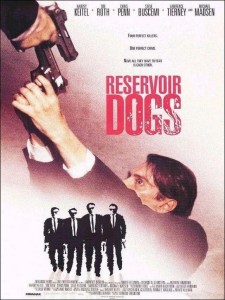 In The 40-Year-Old Critic, Venganza Media creator and host Arnie Carvalho recalls a memorable film for each year of his life. This series appears daily on the Venganza Media Gazette.
In The 40-Year-Old Critic, Venganza Media creator and host Arnie Carvalho recalls a memorable film for each year of his life. This series appears daily on the Venganza Media Gazette.
Are you gonna bark all day, little doggie, or are you gonna review a movie?
Throughout the 1980s American cinemas were dominated by blockbuster, event movies. They rose to prominence in the 70s, starting with Jaws and then Star Wars. By the “Big 80s” big films were the ticket, and the modern movie marketing machine began to form.
By the end of that decade, though, a counterculture of film had started to gain prominence — the indie picture. While this type of low-budget filmmaking was as old as movies themselves, the indies rarely received the publicity and the press afforded to large, studio films. That tide started to turn, in part due to the rise of the Sundance Film Festival in the mid-to-late 80s. Steven Soderbergh achieved critical mass with Sex, Lies, and Videotape in 1989. That same year Jim Sheriden’s My Left Foot was nominated for several Academy Awards, pushing star Daniel Day Lewis into the spotlight.
Both films were distributed by Miramax Films, a studio whose name would be at the center of the 90s indie movement. Studio heads Bob and Harvey Weinstein focused on distribution of smaller independent and foreign films. and the success of those aforementioned 1989 gave the Weinsteins a bully pulpit and legitimacy as they expanded their empire.
While I spent my senior year of high school watching big-budget fare like Lethal Weapon 3, Batman Returns, and Basic Instinct, even at age 17 I could see the shift was happening. I was regularly reading movie and entertainment magazines and following the careers of many actors and directors. I was aware of these low-budget films. Being the teen I was, I tried Sex, Lies, and Videotape, and found it to be much more dull than the titillating title had teased.
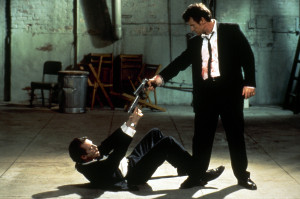
The image that sums up the movie perfectly–men ready to shoot each other.
Although I’d been consuming all of this media, I don’t remember ever hearing about a little film called Reservoir Dogs or its director, Quentin Tarantino. It wasn’t until 1993 — a year after its release — when my lifelong friend and Now Playing Podcast co-host Stuart turned me onto the film.
I had wanted to see True Romance, the 1993 Christian Slater crime film from Top Gun director Tony Scott. I missed it due to friends not wanting to see any film starring Slater post-Kuffs. Thinking I knew Stuart’s taste in film — he certainly was no fan of Slater — I didn’t even ask him, so I was surprised when he later told me he had already seen it and gave it a positive review. He even went out of his way to compliment Bronson Pinchot, of all people, while discussing the movie.
He told me the film was written by the guy who made his directorial debut with the film Reservoir Dogs. As I missed seeing True Romance in theaters (it was only in our town for one week) I immediately went out and rented Dogs with no idea what to expect. I’m not sure I even knew it was an indie film.
I was immediately drawn in. The opening scene had me laughing as the characters sat around deconstructing the lyrics of Madonna’s “Like a Virgin.” The slo-mo opening credits sequence, set to George Baker Selection’s “Little Green Bag”, had me grooving to a song that I hadn’t heard in almost 20 years. These guys were already so cool in their black suits, narrow ties, and sunglasses, and the movie hadn’t even really started.
Reservoir Dogs is really a whodunnit, only we aren’t looking for the identity of a killer, but a rat. Somewhere in this group of cool criminals was an undercover cop. When their jewel heist went bad some members of the gang were killed. The survivors gathered at the designated meeting point, but all are on edge wondering who was the turncoat.
The mystery is revealed through a series of flashbacks. Each of the main villains gets their own sequence showing how they came to be part of the group. As we find out about each member they are ruled out as a cop — until we get to the flashback that makes it explicit.
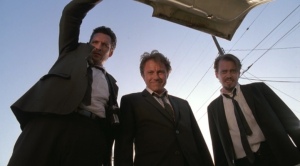
The camerawork in Reservoir Dogs was fresh and exciting. The steadicam following these dogs out of the building–the music fading behind them–was a technique I’d not noticed before watching this movie.
It wouldn’t be until years later that I would realize that through this structure Tarantino had revolutionized cinematic storytelling. Flashbacks were nothing new, but his copious use to unfold a story was uncommon and felt fresh. Today Reservoir Dogs has been copied endlessly — its structure was the template for every episode of Lost, plus hundreds more. Now I consider the flashback story a gimmick. Even Tarantino’s follow-up film Pulp Fiction continued this use, though, while the timeline of that latter film is not chronological, it is also not as scattered as this earlier work.
Watching this film I didn’t realize I was seeing a new storytelling structure that would permeate the mainstream. Through expert editing and story structure I was just drawn into Reservoir Dogs, without excess attention paid to the narrative. The dialogue, the characters, the mystery, it all had me.
Despite being a movie featuring murderous thieves, Tarantino found a way to make them likable characters. The opening scene in the diner, which helped establish a pecking order and general relationships, was a large part of that.
The flashback scenes also built upon this, showing a sense of family among many of the characters and their boss, Joe Cabot. Mr. Blonde (Michael Madsen, in his finest performance to date) is fresh out of prison having refused to rat on his employer. Still on parole, Blonde is afraid of going back. Joe, and his son “Nice Guy Eddie” (Chris Penn) set Blonde up with a fake job and a sense of security, before they do the job.
Likewise Mr. White (Harvey Keitel) is a longtime associate of Joe’s and flashbacks firmly establish their friendship and camaraderie.
The linchpin of the film, however, is Mr. Orange (Tim Roth). He gets the most flashback scenes, and here we get to connect with him outside of the crime family. Tarantino gets much praise for dialogue, and it comes through in these moments.
The sense of pop culture Tarantino put into the film is uncanny. Referencing songs of the 80s while bringing in music from the 70s, Reservoir Dogs clicked with a multitude of audiences. Yet, in a decade before Marvel films were popular, Tarantino referenced Fantastic Four as well — letting this teenage comic fan know a kindred spirit was behind the camera.
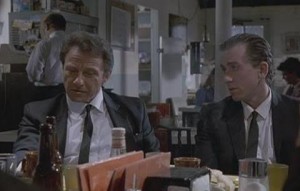
You give me a bad review in a dream you better wake up and apologize.
I also loved the way the soundtrack compiled these songs but, in between, included dialogue from the film. It was rare in 1992 to include anything other than music on a soundtrack. After Reservoir Dogs it became expected, until it — like flashback storytelling — became a tiresome and overused gimmick. With Reservoir Dogs, and then Pulp Fiction, Tarantino’s albums remain my gold standard for this trick.
Beyond all of that came my personal favorite character, the weasely, greedy Mr. Pink (Steve Buscemi). His instinctive sense of self-preservation plus his sardonic sense of humor was all established in his very first scene–he doesn’t tip waitresses. He cares more about his own finances than having compassion for the waitress, and tells this in a highly amusing way. Pink was always my favorite of the Dogs, and for years I thought he, the least trustworthy of all the criminals on screen, was the only survivor. Not only that, it seemed he got away with the diamonds! It wasn’t until 1996 when I saw a limited-run theatrical rerelease that I heard the audio and Pink ended up like the rest of the gang–shot to death.
I can continue to heap praise on this film, and over its 22 year history many have. Yet much of what I appreciated came in retrospect. Watching this film the first time, I was just taken in, and perhaps a bit shocked. Reservoir Dogs is bloody, foul-mouthed, and raw. The casual amorality that Mr. Blonde exhibits when he pulls his captive police officer from the trunk, where the cop had been stored for quite some time, brings the blackest of humor. It is a moment beaten only moments later by Blonde’s torture of the man, set to the jaunty Stealers Wheel’s song “Stuck in the Middle With You.”
This film was my intro to Tarantino, and I was instantly a fan. True Romance solidified that. The next year my dorm room was a practical shrine to the director, with giant Mr. Blonde and Mr. White posters dominating my walls. These films entered heavy rotation, and greatly influenced my creative view. I started tooling with my own crime stories that, at the time, I considered original. Now I realize they were blatant Tarantino rip-offs.
Through my love of Reservoir Dogs I also discovered new directors who followed Tarantino’s path and broke into Hollywood with gritty, genre-bending crime films. From Bryan Singer with The Usual Suspects to Guy Ritchie with Lock, Stock, and Two Smoking Barrels, and even Reservoir Dogs co-writer Roger Avary’s directorial debut Killing Zoe.
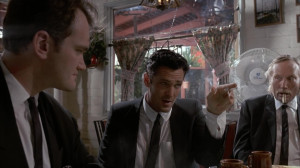
Tarantino pulled off the minor role of Mr. Brown, but he was not as fortunate in future acting gigs.
(I also followed Tarantino’s “acting” career to films like Sleep With Me and Destiny Turns On the Radio. Don’t make the same mistake I did. Never, ever watch Destiny Turns On the Radio)
Tarantino opened the door for indie filmmakers to be taken seriously in the 90s. He also shifted my focus for the rest of the decade, causing me to seek out small films as well as blockbusters, and to sample new directors as well as return to those I already enjoyed.
In the two decades since Reservoir Dogs Tarantino has gone on to win multiple academy awards and put together a very respectable resume of films. There is no doubt the man is a talented director, and an even better wordsmith. Still, to me, his earliest work remains his finest. Even Pulp Fiction, his directorial follow-up to Dogs, became more complex and bloated.
Here, with only the bare essentials and a meager budget, he created a work of genius, and an inspiration to aspiring writers and filmmakers across the country. Including me.
Tomorrow — 1993!
Arnie is a movie critic for Now Playing Podcast, a book reviewer for the Books & Nachos podcast, and co-host of the collecting podcasts Star Wars Action News and Marvelicious Toys. You can follow him on Twitter @thearniec
August 22, 2014 Posted by Arnie C | 40-Year-Old Critic, Movies, Now Playing Podcast, Podcasts, Reviews | 40-Year-Old Critic, Enertainment, Film, Harvey Keitel, Indie, Michael Madsen, Mirimax, Movie, Movies, Now Playing, Now Playing Podcast, Podcasts, Quentin Tarantino, Reservoir Dogs, Review, Reviews, Steve Buscemi, Tarantino, Tim Roth | 3 Comments
-
Archives
- February 2021 (1)
- January 2021 (1)
- December 2020 (1)
- November 2020 (3)
- October 2020 (2)
- September 2020 (1)
- August 2020 (2)
- July 2020 (1)
- June 2020 (1)
- May 2020 (1)
- April 2020 (3)
- March 2020 (2)
-
Categories
-
RSS
Entries RSS
Comments RSS
Site info
Venganza Media GazetteTheme: Andreas04 by Andreas Viklund. Get a free blog at WordPress.com.
